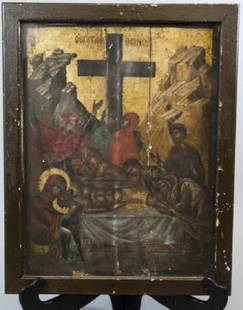
Greek Core-Formed Glass Amphoriskos
Similar Sale History
View More Items in PaintingsRelated Paintings
More Items in Paintings
View MoreRecommended Art
View More







Item Details
Description
**Originally Listed At $2500**
Ancient Greece, ca. 6th to 4th century BCE. A very early example of a core-formed glass amphoriskos (miniature amphora) once used to hold perfumed oil. This near miniature vase boasts an exceptionally elegant form with a spherical body, twin trailed handles that gracefully join the shoulder to the cylindrical neck, and a splayed rim, all upon a rounded bottom. The decoration of this piece is simply breathtaking. Note how the cobalt blue body is wound with azure blue and tangerine orange thread-like trails applied in a close-knit zigzag or feathered pattern around the center with horizontal trails above and below, and a single trail of sky blue around the rim. A divine work of glass art to be treasured for its impeccable form, beautiful hues, and sophisticated technique. Size: 2.75" H (7 cm); 3.25" H (8.3 cm) on included custom stand.
A vessel like this would have been made for the elites of ancient society. Its owner would have used a stopper to keep the contents inside, and a glass rod to dip into the vessel's perfumed oils and dab on the throat or wrists. The little handles made it possible to suspend the vessel, and we know from Athenian vase paintings that vessels like these could be worn off a belt at the waist or suspended from the wrist.
The Greeks created core-formed or sandcore vessels by trailing threads of molten glass over a "core" of sand or clay to form the vessel. These threads were oftentimes feathered or dragged to create intriguing decorative patterns. The term amphoriskos literally means "little amphora" and is indeed a miniature amphora. This shape was quite popular as it was ideal to store precious oils, perfumes, or cosmetics.
According to the Corning Museum of Glass, core forming is "the technique of forming a vessel by winding or gathering molten glass around a core supported by a rod. After forming, the object is removed from the rod and annealed. After annealing, the core is removed by scraping." (https://www.cmog.org/glass-dictionary/core-forming). This process of glass making was begun in the late 16th century BCE by glassmakers of Mesopotamia, and then adopted by Egyptian glassmakers in the 15th century BCE. The technique almost came to an end in the so-called Dark Ages of Mediterranean civilization (1200 to 900 BCE);however, by the 9th century BCE a new generation of glassmakers took up the technique once again, and between the 6th and 4th century BCE core-forming spread throughout the Mediterranean.
For further reading about Core-Formed glass vessels, read Associate Curator, Greek and Roman Art, The Metropolitan Museum of Art C.S. Lightfoot's "The Pendant Possibilities of Core-Formed Glass Bottles" - https://www.metmuseum.org/pubs/journals/1/pdf/1513055.pdf.bannered.pdf
Provenance: private East Coast, USA collection
All items legal to buy/sell under U.S. Statute covering cultural patrimony Code 2600, CHAPTER 14, and are guaranteed to be as described or your money back.
A Certificate of Authenticity will accompany all winning bids.
We ship worldwide to most countries and handle all shipping in-house for your convenience.
#135089
Ancient Greece, ca. 6th to 4th century BCE. A very early example of a core-formed glass amphoriskos (miniature amphora) once used to hold perfumed oil. This near miniature vase boasts an exceptionally elegant form with a spherical body, twin trailed handles that gracefully join the shoulder to the cylindrical neck, and a splayed rim, all upon a rounded bottom. The decoration of this piece is simply breathtaking. Note how the cobalt blue body is wound with azure blue and tangerine orange thread-like trails applied in a close-knit zigzag or feathered pattern around the center with horizontal trails above and below, and a single trail of sky blue around the rim. A divine work of glass art to be treasured for its impeccable form, beautiful hues, and sophisticated technique. Size: 2.75" H (7 cm); 3.25" H (8.3 cm) on included custom stand.
A vessel like this would have been made for the elites of ancient society. Its owner would have used a stopper to keep the contents inside, and a glass rod to dip into the vessel's perfumed oils and dab on the throat or wrists. The little handles made it possible to suspend the vessel, and we know from Athenian vase paintings that vessels like these could be worn off a belt at the waist or suspended from the wrist.
The Greeks created core-formed or sandcore vessels by trailing threads of molten glass over a "core" of sand or clay to form the vessel. These threads were oftentimes feathered or dragged to create intriguing decorative patterns. The term amphoriskos literally means "little amphora" and is indeed a miniature amphora. This shape was quite popular as it was ideal to store precious oils, perfumes, or cosmetics.
According to the Corning Museum of Glass, core forming is "the technique of forming a vessel by winding or gathering molten glass around a core supported by a rod. After forming, the object is removed from the rod and annealed. After annealing, the core is removed by scraping." (https://www.cmog.org/glass-dictionary/core-forming). This process of glass making was begun in the late 16th century BCE by glassmakers of Mesopotamia, and then adopted by Egyptian glassmakers in the 15th century BCE. The technique almost came to an end in the so-called Dark Ages of Mediterranean civilization (1200 to 900 BCE);however, by the 9th century BCE a new generation of glassmakers took up the technique once again, and between the 6th and 4th century BCE core-forming spread throughout the Mediterranean.
For further reading about Core-Formed glass vessels, read Associate Curator, Greek and Roman Art, The Metropolitan Museum of Art C.S. Lightfoot's "The Pendant Possibilities of Core-Formed Glass Bottles" - https://www.metmuseum.org/pubs/journals/1/pdf/1513055.pdf.bannered.pdf
Provenance: private East Coast, USA collection
All items legal to buy/sell under U.S. Statute covering cultural patrimony Code 2600, CHAPTER 14, and are guaranteed to be as described or your money back.
A Certificate of Authenticity will accompany all winning bids.
We ship worldwide to most countries and handle all shipping in-house for your convenience.
#135089
Condition
Repaired from multiple pieces with some visible break lines. Beautiful areas of rainbow iridescence embellish the surface.
Buyer's Premium
- 24.5%
Greek Core-Formed Glass Amphoriskos
Estimate $4,500 - $6,750
5 bidders are watching this item.
Shipping & Pickup Options
Item located in Louisville, CO, usSee Policy for Shipping
Payment

Related Searches
TOP























































![Emilio Grau-Sala "Sur la Plage" Oil on Canvas: Emilio Grau-Sala (Spanish, 1911-1975), "Sur la Plage" [On The Beach], Oil on Canvas, 1958, signed "Grau Sala" lower right, signed, inscribed "Trouville", dated, and titled to verso. Image: 21.5" H x 2](https://p1.liveauctioneers.com/5649/328023/176731071_1_x.jpg?height=310&quality=70&version=1714409606)















